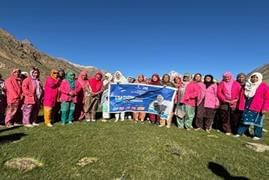PIB Summary - 25th June 2025 | PIB (Press Information Bureau) Summary - UPSC PDF Download
India Launches Largest-Ever Tribal Empowerment Campaign — DhartiAabaJanbhagidari Abhiyan (DAJA)

Context & Significance
This campaign is the largest tribal outreach initiative in independent India, organized by the Ministry of Tribal Affairs.
It honors Birsa Munda, known as Dharti Aaba, who is a symbol of tribal pride, as part of the Janjatiya Gaurav Varsh.
The campaign reflects the Prime Minister's vision of "Sabka Saath, Sabka Vikas, Sabka Vishwas, Sabka Prayas," which means working together for the progress and trust of all.
Scale and Coverage
The campaign will run from June 15 to July 15, 2025.
It will cover over 1 lakh tribal villages and PVTG (Particularly Vulnerable Tribal Groups) habitations across more than 550 districts in 31 states and union territories.
The aim is to reach over 5.5 crore tribal citizens.
Major Outcomes (First 9 Days)
More than 53 lakh tribal citizens reached through over 22,000 camps.
Aadhaar enrolments. 1.38 lakh+
Ayushman Bharat cards issued: 1.68 lakh+
PM-Kisan registrations. 46,000+
PM Ujjwala Yojana enrolments. 22,000+
Jan Dhan accounts opened: 32,000+
Key Services Delivered
- Social Security: Services like pensions, PM-JDY (Pradhan Mantri Jan Dhan Yojana), and Ayushman cards are being provided to ensure social security for tribal citizens.
- Livelihood Support: Livelihood programs such as PM-Kisan (Pradhan Mantri Kisan Samman Nidhi) and start-up support are being delivered to enhance the livelihood opportunities of tribal communities.
- Legal and Land Rights: Assistance is being provided for the Forest Rights Act (FRA) claims to help tribal communities secure their land and legal rights.
- Nutrition and Health: There is a focus on improving nutrition and health, particularly through the promotion of millets and maternal nutrition initiatives.
- Cultural Revival: Efforts are being made to showcase and revive tribal culture, including art, music, and cuisine, to preserve and promote tribal heritage.
Five Pillars of DAJA Governance
- Janbhagidari: This pillar focuses on community participation, ensuring that tribal communities are actively involved in the implementation of programs and initiatives.
- Saturation: The goal is to achieve 100% coverage of eligible households, leaving no one behind in the delivery of services and benefits.
- Cultural Inclusion: This involves the use of tribal languages and art in the implementation of programs, ensuring that cultural aspects are respected and integrated.
- Convergence: Different ministries, civil society organizations (CSOs), and youth groups are encouraged to work together, promoting a collaborative approach to governance.
- Last-Mile Delivery: There is a special focus on delivering services and benefits to remote areas and Particularly Vulnerable Tribal Groups (PVTGs), ensuring that the last mile is covered effectively.
State-Level Highlights
- Ladakh: Emphasis on millet-based tribal nutrition, highlighted during a visit by the Finance Minister.
- Assam: The Chief Minister has identified this initiative as the beginning of a new era in tribal development.
- Maharashtra: Focus on promoting entrepreneurship and self-reliance among tribal communities.
- Kerala:. tribal conclave has been organized to foster collaborative planning for tribal development.
- Andhra Pradesh & Madhya Pradesh: Special attention to including forest-dwelling and vulnerable groups in the development process.
Mobilisation and Participation
- Extensive Involvement: The initiative involves over 3,000 blocks, 700 tribal communities, and 75 Particularly Vulnerable Tribal Groups (PVTGs).
- Support from Various Sectors: There is active support from the MY Bharat campaign, National Service Scheme (NSS), students, and civil society organizations (CSOs).
- Cultural Celebrations: The initiative includes pan-India cultural celebrations showcasing tribal cuisine, dances, and crafts, promoting tribal culture and heritage.
Vision and Impact
- Inclusive Governance: The initiative represents a step towards inclusive and participatory governance, ensuring that tribal communities are at the forefront of decision-making and implementation.
- New Benchmark: It sets a new standard in service delivery focused on tribal needs, ensuring that services are tailored to the specific requirements of tribal communities.
- Grassroots Revolution: The initiative is perceived as a grassroots revolution aimed at enhancing the dignity and identity of tribal communities, empowering them and recognizing their contributions and rights.
A new innovation cleans water with the help of Sunlight, Vibration and Artificial Intelligence (AI), enables Bio-degradable, Eco-friendly and Low-cost Technology

Context and Innovation Overview
- Researchers at the Indian Institute of Science, Mohali, under the Department of Science and Technology (DST), have developed a new water purification system that is biodegradable, eco-friendly, and low-cost.
- This innovative system targets industrial dye pollutants such as Methylene Blue and Congo Red found in wastewater.
- The purification process combines sunlight, mechanical vibrations, and Artificial Intelligence (AI), creating a sustainable and efficient solution for water treatment.
- This technology is relevant to GS Paper 3 (Science and Technology, Environment – Pollution) as it addresses the critical issue of water pollution with an innovative approach.
The Technology Explained
- Core Structure: The system is built on a 3D-printed scaffold made from Polylactic Acid (PLA), which is a biodegradable polymer.
- Catalyst: The catalyst used is Bismuth Ferrite (BiFeO₃), which is coated on the PLA scaffold. This combination enables piezo-photocatalysis,. process that enhances pollutant degradation using both light and mechanical energy.
- Principle: The technology relies on two main processes:
- Photocatalysis: Sunlight activates the BiFeO₃ catalyst, which helps break down the pollutants in the water.
- Piezocatalysis: Gentle mechanical vibrations trigger the catalyst, making it effective even on cloudy days when sunlight is less intense.
- Result: The combination of solar and mechanical energy leads to efficient degradation of pollutants, making the system robust and reliable.
AI-Driven Smart Efficiency
- Machine Learning Models: Advanced machine learning models, such as Artificial Neural Networks, are trained to predict the performance of the water purification system under various conditions.
- High Accuracy: These models achieve up to 99% accuracy in their predictions, helping to optimize the system's real-world application and scalability.
Performance Highlights
- The system has demonstrated impressive performance by removing 98.9% of Congo Red and 74.3% of Methylene Blue from wastewater.
- It has outperformed many conventional water treatment systems that are often high in cost.
- Notably, this technology completely avoids the use of hazardous chemicals or energy-intensive techniques, making it a safer and more sustainable option for water purification.
Environmental and Industrial Relevance
- Eco-friendly and Reusable: The system is made of biodegradable PLA, making it environmentally friendly and suitable for reuse.
- Low-cost and Scalable: The technology is accessible to both industries and rural communities, offering a low-cost solution for water purification.
- Fossil Fuel-free Operation: The system operates on renewable solar and mechanical energy, aligning with sustainability goals and reducing dependence on fossil fuels.
Sustainable Development Implications
- The water purification system contributes to Sustainable Development Goal 6 (SDG 6): Clean Water and Sanitation. It also supports other goals such as SDG 9 (Innovation), SDG 12 (Responsible Consumption), and SDG 13 (Climate Action).
- The technology is ideal for circular economy models, making it suitable for industries like textiles and pharmaceuticals, where water pollution is a significant concern.
FAQs on PIB Summary - 25th June 2025 - PIB (Press Information Bureau) Summary - UPSC
| 1. What is the DhartiAabaJanbhagidari Abhiyan (DAJA) and what are its primary objectives? |  |
| 2. How does the new innovation for water purification utilize sunlight, vibration, and artificial intelligence? |  |
| 3. What are the expected benefits of the tribal empowerment campaign for local communities? |  |
| 4. In what ways can artificial intelligence contribute to sustainable development in tribal regions? |  |
| 5. Why is it important to focus on eco-friendly technologies in initiatives like DAJA? |  |
















